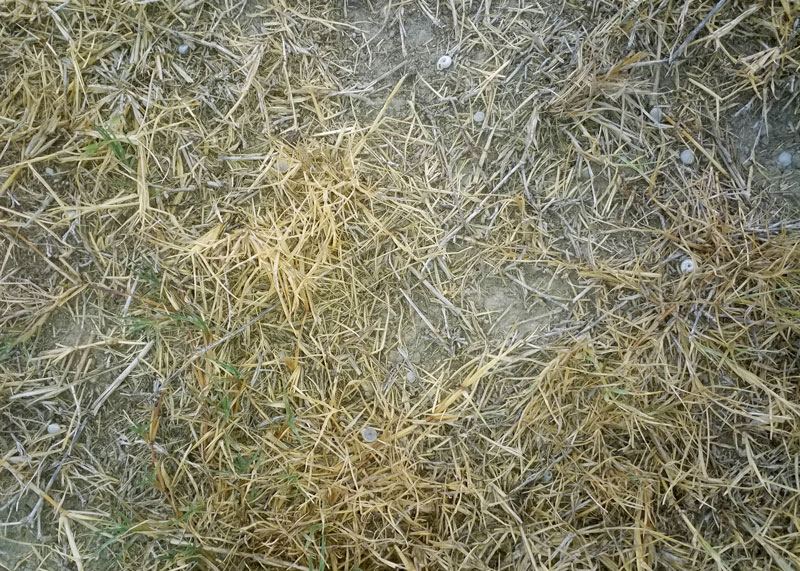Q&A – Ask Neil: July 28, 2022
(Please read these instructions carefully.)
We’ve received really nice comments on this much-expanded way of addressing questions I’m asked. Before you post your own question, I might suggest you look at recent issues to see if someone else has already asked it. You might find your answer there.
• Click here to post your question.
• After you submit your question, a new window will pop up giving you the address to which you can e-mail a photo to accompany your question. Clear, medium-resolution photos. (Try to avoid low-res thumbnail photos, please, in case I have to zoom in to see things.)
• Please only post your question one time.
• One question per reader, please.
• Please use this only for posting questions – not for standard emails.
• Watch for your answer in the following week’s e-gardens.
• I choose those of greatest general interest. For example, plant IDs seldom make the cut.
• I must have your first name or initials.
• I must have your city or county. (Texas is a very large state.)
QUESTION 1
PLANT HARDY HIBISCUS NOW?
Question: I found a hardy hibiscus today. I know it’s best to plant them in the spring. Should I put it in a larger pot until then or bring it inside during frosts? Tamela J., Harker Heights.
Answer: If it is growing vigorously now, I would go ahead and plant it into a sunny location with well-prepared garden soil. You can always mulch over it this winter, although they’re cold hardy to -10F and below. It will have much better odds in the ground than it would have in a pot.
QUESTION 2
ARE ANTS A PROBLEM ON BASE OF CRAPE MYRTLE?
Question: I have ants swarming on the trunks of my crape myrtle trees. I applied a tree and shrub drench last October and March. Should I be concerned about them? Carol S., Dallas.
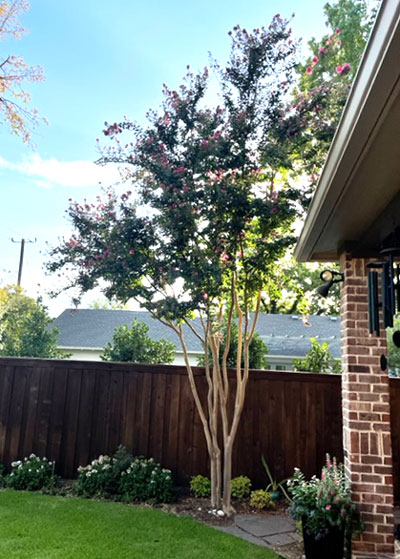
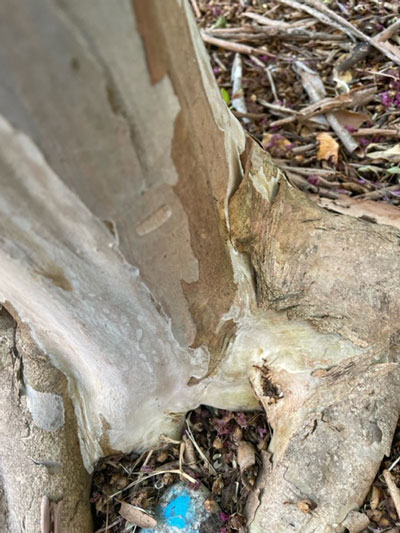
Answer: Ants aren’t going to hurt a crape myrtle. If you’re seeing mounds forming they may be fire ants. I can’t tell from your photo. In that case I would use one of the fire ant baits. Otherwise, I wouldn’t worry about them. In case you’re new to Texas and unfamiliar with fire ants, they’re the small, dark ants that sting ferociously resulting in a white pustule the following day.
QUESTION 3
WHY DO HIBISCUS FLOWERS NOT OPEN?
Question: I bought a red hibiscus. It produces buds but they never open. I water it every day. It’s in full sun on the west side of my house. What’s wrong? Judy W., Alvin.
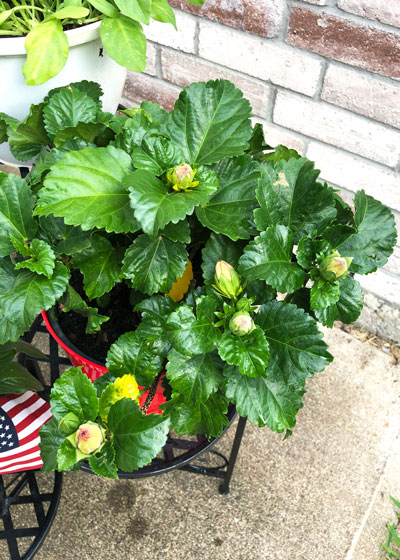
Answer: Many members of the hibiscus clan are known for aborting their buds when summer rolls in. Roses-of-Sharon are notorious for it, but so are tropical hibiscus. It happens most commonly when the plants are in pots and when they become rootbound. If your plant is in a container, try moving it into a spot that gets morning sun and shade from noon until 4 or 5. If it dries out daily you might need to repot it into the next larger pot size. It will probably do much better this fall.
QUESTION 4
DO WE NEED TWO APPLICATIONS OF PRE-EMERGENTS IN FALL?
Question: Is it time to make two applications of pre-emergent herbicide in the fall? I’ve applied it in September the past few years, but I’ve ended up with annual bluegrass each spring. It starts west of the house and south of the fence (red circle). Kirk M., White Settlement.
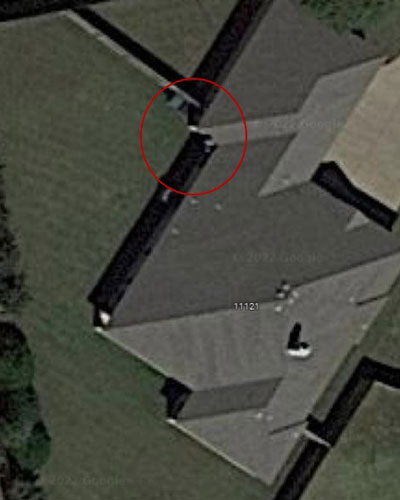
Answer: That’s a fair question, although “September” is a rather general application time. I used to recommend the first 10 days of September and so many people reported that they had annual bluegrass (Poa annua) anyway that I moved my target date back to August 25 through September 5. I guess if you wanted to follow that up with a second application of Dimension, Balan or Halts in early November you could try it, but no manufacturer has ever suggested that to me. We’ve had unusually dry early falls the past several years. They have rendered the pre-emergents somewhat ineffective in many settings.
QUESTION 5
ARE THESE EXPOSED ROOTS NORMAL FOR PHILODENDRONS?
Question: My philodendron is doing very well, but I’m wondering if these surface roots are normal. Do I need to repot the plant into a larger container? If so, how high on the stem should the soil be? Regina C., Salado.
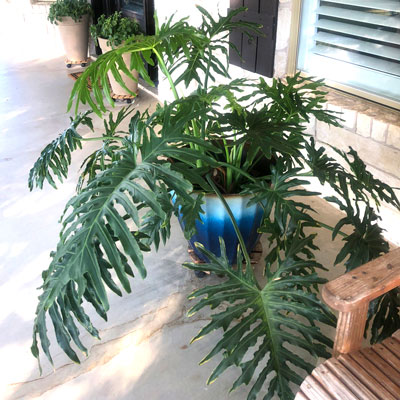
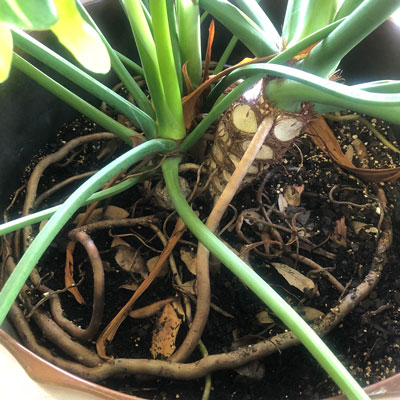
Answer: They are completely normal for “self-heading” (non-vining) philodendrons. They do not necessarily indicate a need for repotting. I use comparative size of the plant to its pot as my means of determining when to repot. When the plant becomes more than 4 or 5 times the height or width of the pot I start thinking about giving it a new home. Repot it at the same level at which it had been growing previously. You can trim off these odd roots as you wish.
QUESTION 6
CAN FLOWERS BE PLANTED BENEATH POST OAKS?
Question: Can flowers be planted beneath post oaks? I have heard that daily watering of flowers will hurt the trees. Karen C., Hurst.
Answer: I describe post oaks (Quercus stellata) as “grumpy old trees that hate human beings.” They seem to be looking for any excuse to die. When we start building homes in neighborhoods where post oaks are native it’s imperative that we do as little grade changing, trenching and other landscape improving as possible. That would include developing elaborate flowerbeds. If I had post oaks and if their shade was heavy enough that normal turfgrass wouldn’t survive for me (it usually will), I would develop some type of simple groundcover bed, perhaps Asian jasmine or purple wintercreeper euonymus. I especially like the wintercreeper because it requires even less bed preparation, is more drought tolerant and won’t freeze in extreme cold. Then I would set several large flat stones within the bed on which I could position attractive and simple pots. I’d put my color plantings into those pots. Problem solved, and I didn’t have to disturb the post oaks to have color in my landscape.
QUESTION 7
DID SNAILS KILL THIS BERMUDAGRASS?
Question: Our backyard lawn is dying, I believe because of snails. How can we eliminate them? Simone C., Weatherford.
Answer: Snails feed on tender new growth, so they can be a problem in flower and vegetable gardens as seedlings start growing. I have snails like this all through my yard, actually in larger numbers than I’m seeing in your photo, and I’ve never seen them do any damage. I can’t tell what has caused your bermuda to turn brown so dramatically, but my first guess would be that it, like so many lawns, has probably gotten quite dry over the course of this summer. I would try scalping it to get rid of the stubble, then watering it deeply. In a few weeks apply an all-nitrogen plant food to stimulate a flush of fall growth. There may be some other problem involved, but for example, I’m not seeing bermuda mite damage or Pythium blight – two of the more common summer problems. Is there any chance that you might have applied a weedkiller spray that was not labeled for use on bermuda to your lawn? The browning is so complete that that’s what it looks like.
QUESTION 8
WILL OLD TOMATO PLANTS BEAR MORE FRUIT, OR SHOULD I PLANT FALL TOMATOES NOW?
Question: I have San Marzano tomato plants that are continuing to bloom. I am also hearing that August is the time to plant fall tomato plants. Will my existing plants continue to bear, or should I plant new plants? Linda B., McKinney.
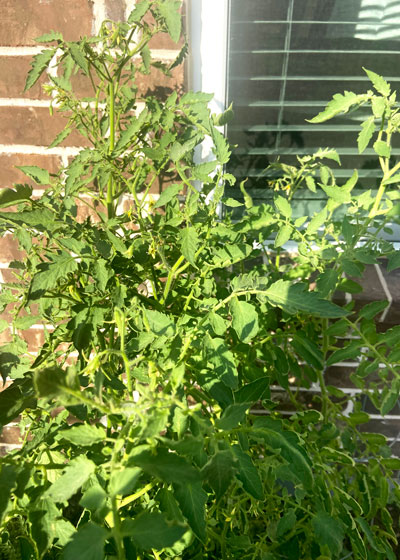
Answer: Please look back in your e-mails to e-gardens from June 30. That was our “fall tomato” story issue. They must be planted between June 25-ish and July 4 to give them enough time to mature before the first killing freeze. Here is a link to that story. https://neilsperry.com/2022/06/time-here-for-fall-tomatoes-now-2/ You’ll also see my comments that fresh, new plants will outproduce hold-over plants severalfold. But at this point you might as well hang onto what you have and hope they can survive the balance of this crazy summer.
QUESTION 9
WHAT HAS HAPPENED TO THE FRUIT OF MY BRADFORD PEARS?
Question: I have two Bradford pears. This year many of the falling fruit look like clover flowers. What is this? Craig S., Lake Kiowa.
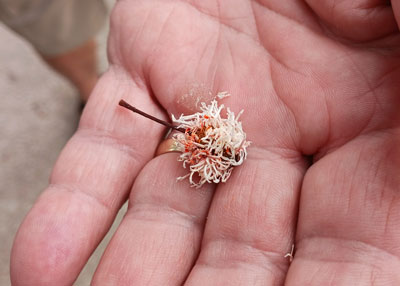
Answer: You may be familiar with cedar-apple rust that moves alternately between eastern redcedar trees and apples and crabapples. This is its cousin, cedar-pear-quince rust. It requires eastern redcedars and pears or quince as its two host plants in order to complete its life cycle. These probably started out with more of an orange color to them (hence the name “rust”), but they have faded to white as they matured and the fruit fell to the ground. As this article points out, they are harmless to ornamental pears and quinces.
QUESTION 10
WHY DO CRAPE MYRTLE LEAVES LOOK LIKE PLANT IS DRY?
Question: My crape myrtles’ leaves are pointing downward as if they need water, but I water them frequently. What is wrong? Courtney W., Bryan.
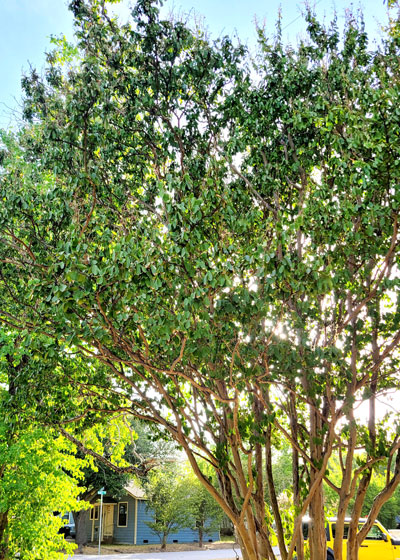
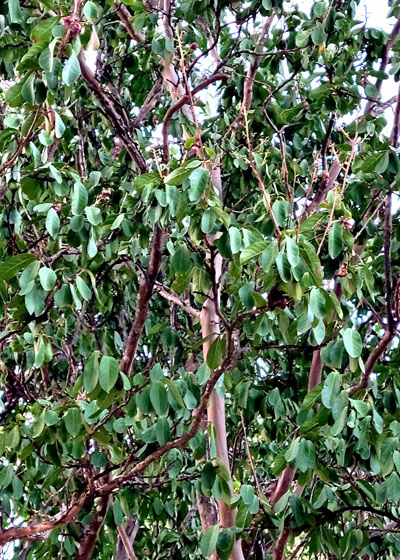
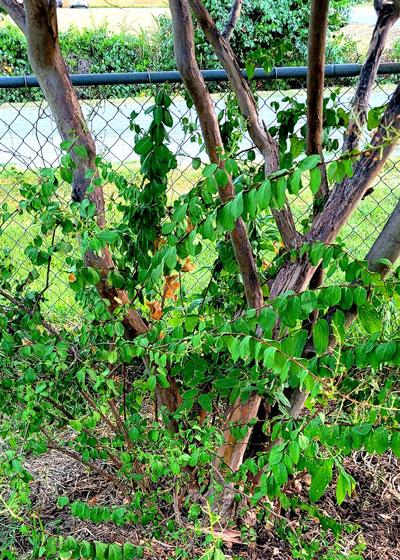
Answer: I spend several hours each day working with crape myrtles and The Crape Myrtle Trails of McKinney. I know of no insect or disease that would cause this symptom. Even aphids and crape myrtle bark scale wouldn’t end up looking like this. Dry soils certainly will. Let your hose run slowly for several hours as you soak each plant’s root zone deeply and thoroughly. The plants may suffer leaf yellowing and premature fall, but the leaves should perk back up.
QUESTION 11
WHAT IS THE WHITISH-GREEN MOSSY GROWTH ON LIVE OAK’S TRUNK?
Question: What is this white/mossy green stuff growing on the trunk of my live oak? If I need to remove it how should I do so? Randa M., Austin.
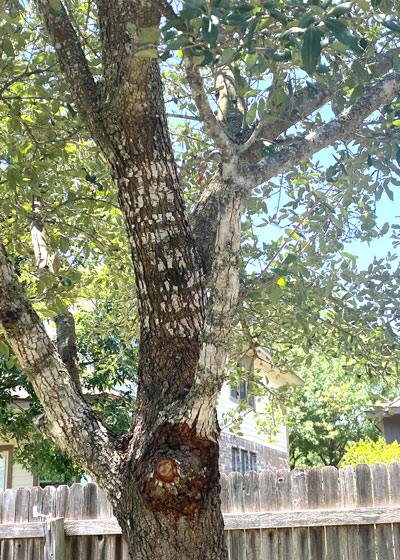
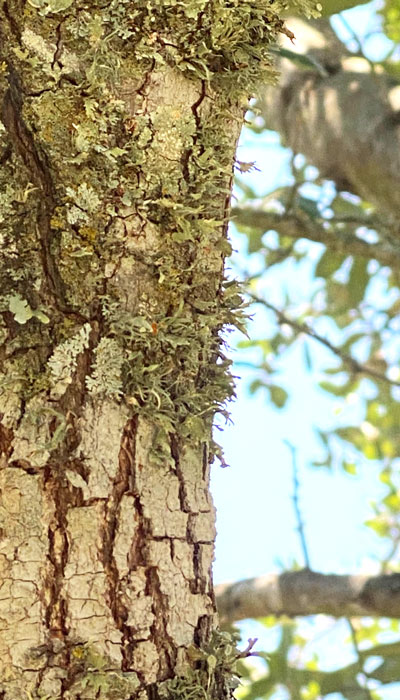
Answer: These are lichens. You may have seen others’ questions on the same topic in recent weeks here. The one thing that is different about yours is that your tree has also been visited by a woodpecker. It was the source of the rows of holes around the trunk and limbs. Neither the lichens nor the woodpecker causes any problems, nor does either call for any type of control. You are freed to worry about something else.
QUESTION 12
HOW CAN I GET RID OF GOPHERS?
Question: How can I get rid of gophers? Juliet W., Denison.
Answer: Here is the answer I have in the FAQ pages of my website:
Question: How can I tell if I have gophers or moles in my lawn? What will eliminate them?
Answer: There is a great deal of confusion in identification and control of these two damaging animals. Both will be most common in areas with sandy soils. Here are the details on each pest.
Gophers have small external ears and eyes. Their front incisor teeth are always exposed. Gophers are rodents, and more closely resemble squirrels in their head and facial features. Gophers feed on roots that they encounter while digging. They may also feed on above-ground vegetation that is very close to the openings of their tunnels, and they may actually pull plants into their tunnels from below. They feed on all manners of plants, from grasses and annuals to shrubs and even trees. Gopher mounds are generally kidney-shaped and made of finely sifted soil. Gophers usually have larger mounds, and they often are in line with one another. Control them with poison baits that are placed into their tunnel systems. Remove any bait that spills on the surface of the ground. Locate the main tunnel, place the bait within it, then seal off any opening you have made.
Moles have hairless, pointed snouts extending nearly 1/2-inch in front of their mouth opening. Their small eyes and the opening of their ear canals are concealed in fur, and there are no external ears. Moles are insectivores, related to bats. Moles are generally found in cool, moist and shaded soils that are populated by earthworms and grub worms. Moles leave volcano-shaped hills that are often made up of clods of soil. Moles are best controlled using traps that are implanted into depressed portions of the surface tunnels. As the moles push up to re-open their tunnels, the traps are triggered.
For the record, commercially available sonic devices that claim to scare gophers away are reportedly ineffective, as are the plants, gopher purge and castor bean, both of which have been claimed to drive the animals away.
QUESTION 13
WHAT CAN BE DONE ABOUT LACE BUGS?
Question: I’ve never seen lace bugs this bad on my bur oak tree. Is this cause for worry? A second bur oak less than 100 feet away has no lace bugs whatsoever. Mike N., Lucas.
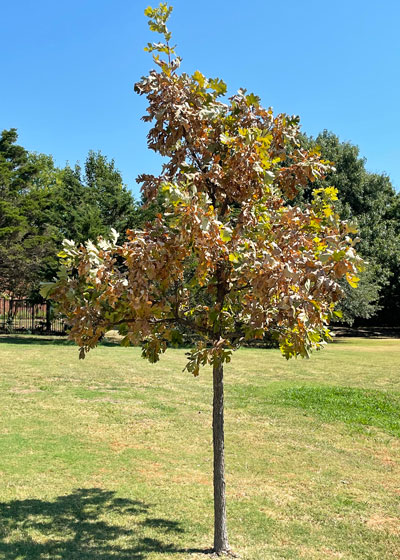
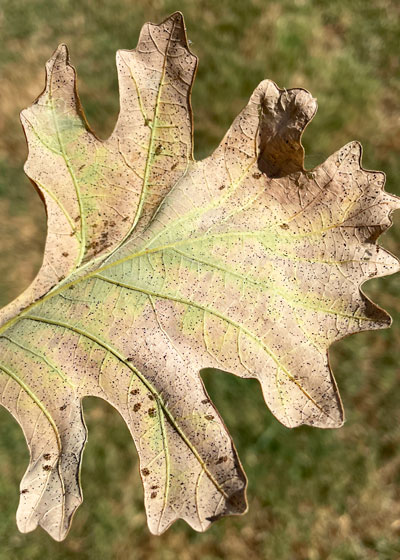

Answer: There may be a genetic difference between the two oaks that makes one more attractive to the lace bugs. Or it could just be a chance happening. In either case, this is a serious outbreak but the tree will start with a fresh set of leaves next spring and should be just fine. You might want to apply a systemic insecticide a month prior to when you first saw the stippling this summer to stay ahead of them next time around. Apply it as a soil drench around the drip line.
QUESTION 14
WHAT IS DRIPPING FROM LIVE OAK?
Question: I am finding several areas where a substance is dripping onto our driveway beneath a 50-foot canopy live oak. The drips are coming from limbs 1-4 inches in diameter. The substance is sticky and attractive to ants. Is it sap? Honeydew? Bill G., Corinth.
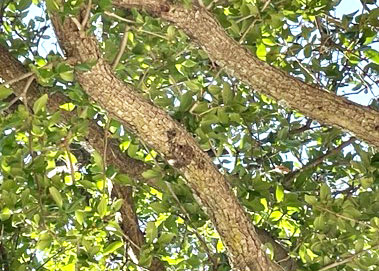
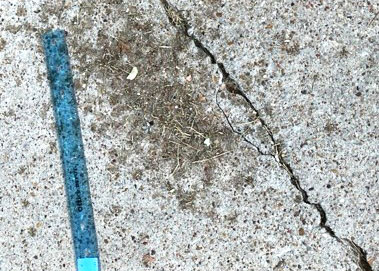
Answer: It’s too concentrated and localized to be honeydew so I’m guessing that it’s sap. However, that would suggest that there is some kind of injury or decay. Your photos are thumbnails. I can’t zoom in enough to make out details. If you have a certified arborist who routinely checks the trees on your property, have him or her look at this tree in particular next time they stop by for a visit. (I believe our advertiser, Arborilogical Services, provides service to Corinth.)
QUESTION 15
WHY ARE FALSE HOLLY AND PLUM YEW TURNING BROWN?
Question: Why are my false holly (Osmanthus) and plum yew leaves turning brown. I water them three times per week. I fertilized them one month ago with all-nitrogen food. They have gotten worse in the week since I took the photos. Ron L., McKinney.
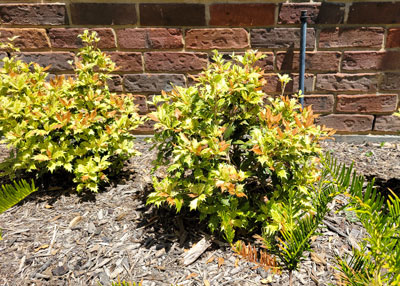
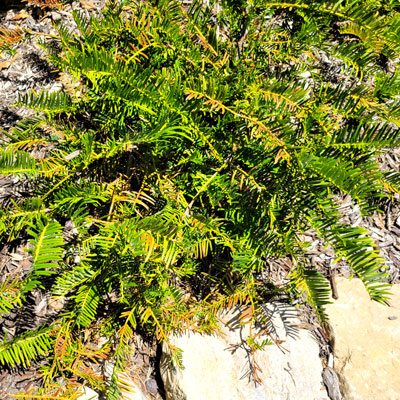
Answer: Both of these plants are best suited to semi-shaded or shady locations. In fact, exposure to sun after mid-morning can be very hard on them, especially in a harsh summer like this. I live in McKinney. As I drive the streets and walk the walks I see very few osmanthus plants other than in very shady fern gardens. I’m seeing more plum yews, even in large commercial landscapes. They really struggled with the cold of February 2021, and the ones I’ve seen in one commercial landscape are suffering from exposure to sun this summer. If your plants survive the balance of the summer you should transplant them come winter.

